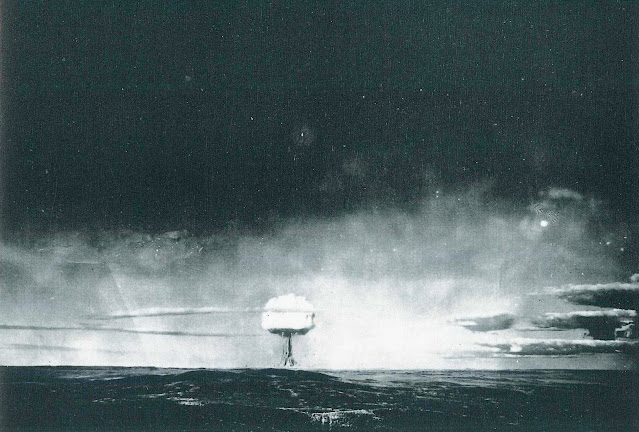Joe-4 (RSD-6s) is the nickname for the first Soviet test of a thermonuclear weapon by fusion, conducted on August 12, 1953, and the fourth American nuclear test. It was detonated at Semipalatinsk, Kazakhstan, with the equivalent of about 400 kilotons of TNT. The combination of fusion energy and fission of neutrons made it about ten times more powerful than a fission-type atomic bomb. Fission and fusion were stratified, with a power distribution of about 10% from uranium-235 fission, 20% from fusion, and 70% from uranium fission. Joe 4 was touted as a true hydrogen bomb. American experts denied that it was a hydrogen bomb. The Soviet true hydrogen bomb, code-named RDS-37, was tested on November 22, 1955. All of them were carried out at the Semipalatinsk nuclear test site of the Kazakh SSR.
The Soviets began research on nuclear and hydrogen bombs in June 1948. Deuterium and uranium-238 were alternately layered around a fissile core. The Soviet nuclear program expanded during the early 1950s to include atomic and hydrogen bombs, accelerating their power during the Cold War. The Soviets, at a disadvantage in the accuracy and reliability of their nuclear weapons delivery, developed larger and more powerful bombs. This was tested by the Soviets with the development of the massive super bomb Tsaribomba, which dropped 50 megatons of TNT in 1961. The U.S., by contrast, focused on developing smaller, more effective nuclear weapons that could be deployed on medium-range ballistic missiles (MRBMs) and intercontinental ballistic missiles (ICBMs).
The Semipalatinsk landfill is the only nuclear weapons test site in the world where people have always lived. During the nearly 40 years of nuclear testing, not a single settlement has been closed. No one has been evicted from the danger zone since the closure of the landfill. The Soviet Union carried out 456 nuclear tests in Semipalatinsk from 1949 to 1989. A significant amount of radioactive material, including plutonium, has now been abandoned. In a longitudinal study spanning almost 40 years, exposure to fallout was correlated with the prevalence of solid tumors.


